Welcome to part three of our four-part Carmilla celebration. If you missed part one or two, you can get caught up here.
Author's note: This essay discusses themes of self-harm and suicide. If you are experiencing thoughts of suicide, counselors at The Trevor Project are available 24/7.
"A strange melancholy was stealing over me, a melancholy that I would not have interrupted. Dim thoughts of death began to open, and an idea that I was slowly sinking took gentle, and, somehow, not unwelcome, possession of me."
What Sheridan Le Fanu's Carmilla lacks in action, it makes up for in dreams. A subtle sense of unreality swathes the narrative like silk organza, a thin veil — or is it a shroud? — obscuring Laura's point of view. Her story is full of eerie, evasive imagery, like a spirit whose face cannot be seen head-on. Both Carmilla and her father know things they are not telling her, and their reticence gives Laura's narration the quality of a half-remembered nightmare — vivid in some areas and obscure in others. It's as if she lives in that heavy-lidded space between sleep and waking: Emotions surge through her, but she struggles to place the images attached to them.
Laura first glimpses Carmilla in a dream. Towards the novella's beginning, Laura tells the reader that when she was six years old, she woke with a start one night to see "a solemn, but very pretty face looking at me from the side of the bed." The figure drew young Laura to her, and the fear fluttering in her chest subsided, but then "a sensation as if two needles ran into my breast very deep" made Laura cry out, and the figure was gone. When Laura and Carmilla meet again, Carmilla confirms that she also saw Laura in a dream some 12 years past. "It does seem we were destined, from our earliest childhood, to be friends," she says.
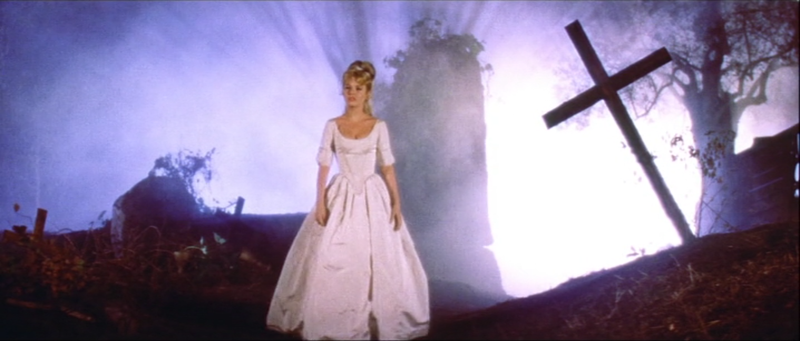
Once Carmilla moves into Laura's father's house, Laura begins dreaming of a long, lithe animal that looks like a gigantic black cat accompanied by a woman in a long, loose dress, her hair unbound and her expression unmoving. She also dreams of being in a dark room, commanded by a woman's voice that sounds as if it is very far away. She feels hands caressing her cheeks and neck, then lips. "My heart beat faster, my breathing rose and fell rapidly and full drawn; a sobbing, that rose into a sense of strangulation, supervened, and turned into a dreadful convulsion, in which my senses left me and I became unconscious," she says.
Carmilla also runs hot and cold. Le Fanu describes her as "languid," moving only when necessary. When she does, she does so slowly, as if she is underwater. She sleeps all day, eats very little, and is easily tired. But she is also prone to fits of violent passion, telling Laura that "you are mine, you shall be mine, you and I are one forever," her breathing quick and her eyes glowing like coals. Laura only sees Carmilla this worked up twice: Once when Carmilla declares her eternal devotion, and once when the girls hear a passing procession singing funeral hymns. Angered by the display, Carmilla denounces religion, declaring that "you must die—everyone must die; and all are happier when they do!"
Looking at Carmilla as a coming-of-age story, it's hard not to imagine the teenage vampire, stomping her feet and sticking her fingers in her ears in defiance of God, as suffering from a sort of proto-teen angst. Adolescence can be a dark and harrowing time — especially for LGBTQ+ youth, 45% of whom told the Trevor Project that they had seriously considered suicide in 2021. Carmilla carries with her a darkness that envelops the girls she falls for/preys upon, a darkness with a morbid fascination and a romance all its own.
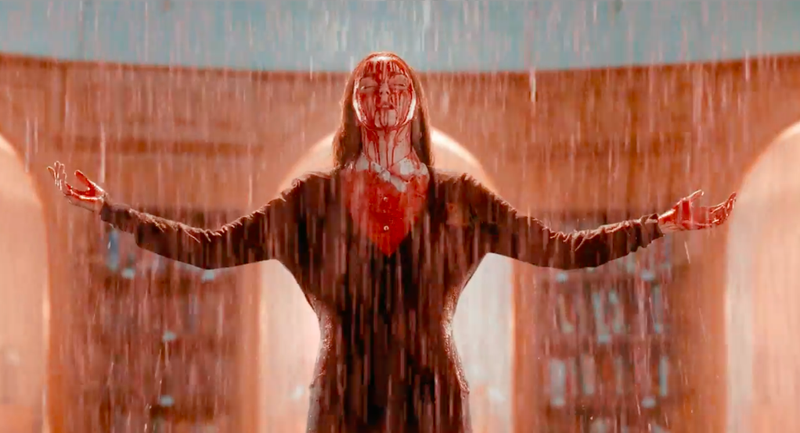
Mary Harron's 2011 film adaptation of Rachel Klein's novel The Moth Diaries puts Carmilla into the context of teen movies, placing its skeptical narrator Rebecca (Sarah Bolger) and eerie interloper Ernessa (Lily Cole) at an elite all-girls' boarding school plagued by a series of inexplicable deaths. The Moth Diaries does have a queer subtext, which breaks the surface into text when Rebecca walks in on Ernessa feeding on one of her classmates, naked and moaning, in the dormitories one night. The film also recontextualizes Carmilla's aversion to food as a modern eating disorder, as Rebecca watches her best friend Lucy (Sarah Gadon) waste away under Ernessa's intense, possessive gaze.
But more than that, The Moth Diaries is a film about being seduced by death itself. Although she spends much of the film taking Rebecca's friends out of the picture one by one, Ernessa does so to isolate Rebecca, the true object of her morbid obsession. Both Ernessa and Rebecca lost their fathers to suicide, and Ernessa wants to be known by someone who is as intimate with the void as she is. It's an ardor that "resembles" love —a word used frequently in both The Moth Diaries and Carmilla — but is not actually love.
Ernessa is as shifting and impermanent as life itself, dissipating into clouds of white-winged moths that shine in the moonlight like little souls. Her methods are cruel: She gives Rebecca a razor, knowing full well that Rebecca's poet dad died after cutting his wrists in a bathtub. Rebecca lightly traces the razor over her own wrists, asking herself if his illness runs through her veins as well. And Ernessa encourages these doubts, telling Rebecca that "the moment of death is ecstatic. It's the most joyful sensation." Theirs is a private world of pain and grief, as invisible to outsiders as the deluge of blood Ernessa invokes by slicing her arm and singing a nursery rhyme:
"My mother, she butchered me, my father, he ate me, my sister, little Anne-Marie, she gathered up the bones of me and tied them in a silken cloth to lay under the juniper."
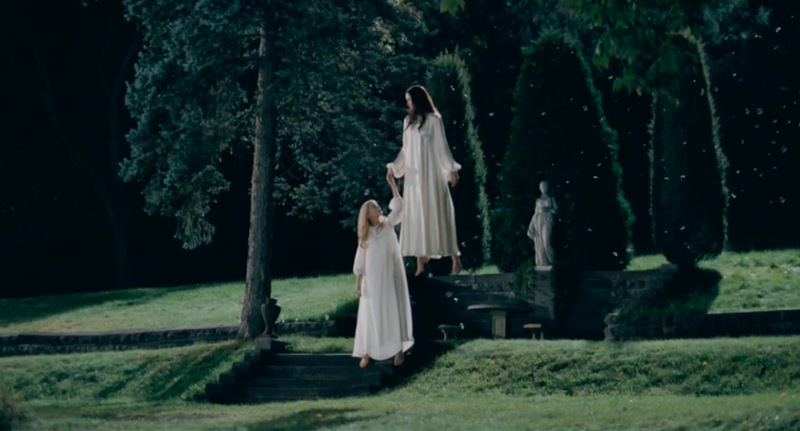
The Moth Diaries is tragically misunderstood, dismissed by critics and audiences alike as a weak and not very scary vampire story. But it isn't meant to be scary — at least, not in a jump-out-of-your-seat kind of way. Instead, it's a compassionate and deeply sad film, one that understands the bottomless pits that live inside teenage girls and offers them a hand to hold in the darkness. The Moth Diaries ends with Rebecca throwing Ernessa's razor out of the window of a moving car. She has chosen to live, on her own terms.
The connection between languorous vampires draining ecstatic victims and more earthbound forms of fetishism is made even more explicit in The Unwanted (2014), a gritty retelling of the Carmilla story set in Appalachian Georgia and soundtracked by some surprisingly good indie-rock tunes. If you take the supernatural element out of the story as The Unwanted does, what's left is, essentially, a BDSM romance featuring lesbian bloodplay. And The Unwanted goes there like few other adaptations do. The film's Laura (Hanna Fierman) has a rocky relationship with her father, who hates and distrusts his daughter. He blames her for Laura's mother abandoning him for another woman, and accuses her of being "like her mother."
Laura copes with the stress by cutting herself. Her thighs and arms are covered in rows of tiny scars, a roadmap of her trauma and emotional fragility. In classic lesbian-vampire style, a mysterious drifter named Carmilla (Christen Orr) appears at the beginning of the story looking for her mother, who turns out to have been Laura's mother's lover. Carmilla tenderly kisses Laura's scars, and the two incorporate blood and cutting into their lovemaking; this is framed as a healing experience for Laura, who asks Carmilla in a daze, "Is this what love is supposed to feel like?"
Blood plays a more sinister role in the original Carmilla: The vampire's seduction of Laura is a largely bloodless affair, but once her father actually lets her in on what's happening to her, Carmilla abruptly transforms from Laura's confidant to a horrific fiend. At the end of the book, Laura, her father, and General Spielsdorf — a nobleman whose niece was recently drained of blood by a mysterious girl named Mircalla — find Carmilla/Mircalla lying in a lead coffin, "floated with blood, in which to a depth of seven inches, the body lay immersed." This particular detail, though quite cinematic, doesn't appear in any of the more literal Carmilla adaptations; it can be seen in the climactic scene of Alucarda (1977), a deliciously blasphemous blend of lesbian vampires and Satanic mayhem from Mexican director Juan López Moctezuma.
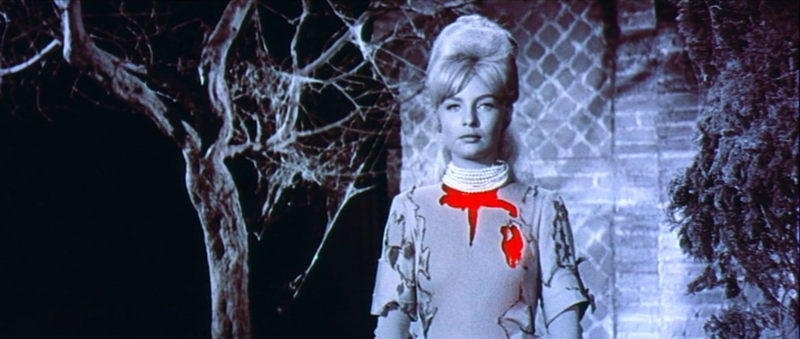
Nevertheless, Carmilla adaptations are full of vivid, disorienting visuals. In Blood and Roses (1960), fireworks awaken the unnatural creature slumbering in the Karnstein crypt, an effervescent, brightly colored series of explosions that contrast with the decrepit moldiness of the tomb. That film also makes use of strobe effects and splashes of ripe, juicy blood red in an erotically charged, bold surrealist black-and-white dream sequence. The strobe technique is also seen in The Blood-Spattered Bride (1972), although that's not nearly as surreal as the scene where Susan's husband is walking along a beach and sees a pole sticking out of the sand. He walks over and wipes away the sand, only to expose a pair of eyes behind plastic. It's Carmilla, topless and buried in the sand, breathing through a snorkel.

But one image recurs throughout all Carmilla adaptations, whether faithful or loose, contemporary or historical, classy or trashy. That's the literal manifestation of the veil that obscures Carmilla's true nature, expressed in one (or more!) of three ways: A nightgown, a wedding dress, or a burial shroud. (The Nightmare Classics version of Carmilla (1989) offers a unique spin on the theme. The heroines stroll the grounds of an antebellum plantation in enormous white ball gowns, weighed down by their heavy skirts and oppressive social norms.) Taken together, the three garments stand in for the life cycle of a passive, pliant, "good" Victorian woman: The innocent girl, the blushing bride, and the decrepit crone. But as she always does, Carmilla finds a way to queer the shroud.
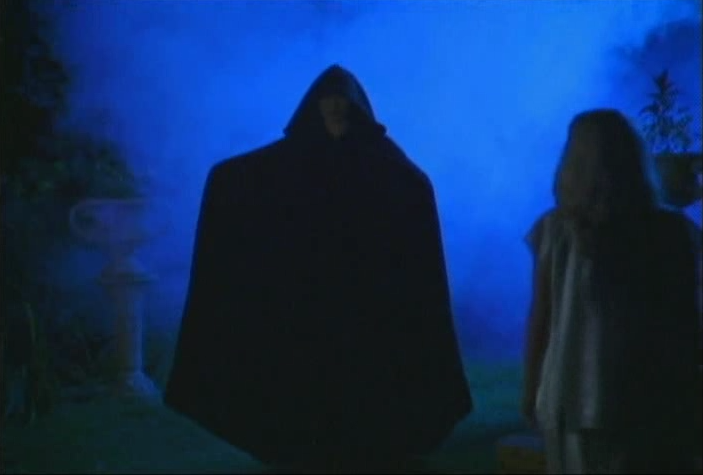
In the novella, Carmilla wanders the misty, verdant grounds of Laura's father's estate at night, dressed in a long white nightgown that makes her appear as a ghost to those who spot her from far away. This romantic, haunting image recurs over and over again in Carmilla movies; even The Vampire Carmilla (1999) re-creates it, in its ultra-low-budget, fuzzy VHS way. And Hammer's Karnstein Trilogy extends the necklines on its white nightgowns as low as they can possibly go. But despite their fixation on heaving, overflowing ….err, life, these films also give death a certain elegance.
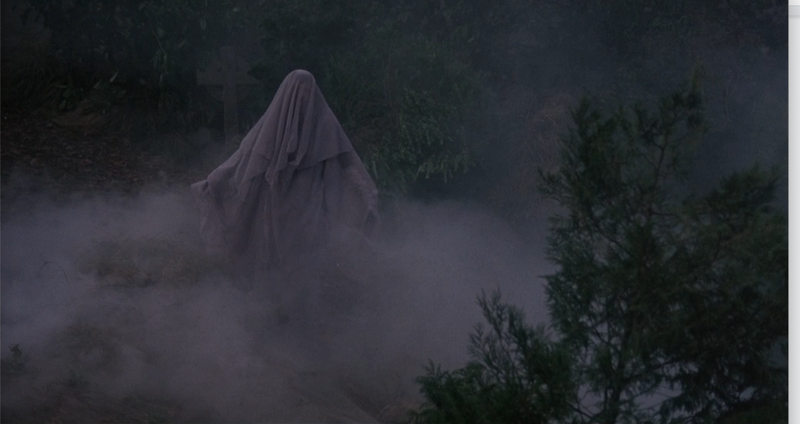
In the opening scene of The Vampire Lovers, a nobleman besieged by vampires watches in horror from a turret of his castle as a vampire, draped head to toe in purplish gray fabric, emerges from its grave. Enveloped in mist, it dips and twirls like a modern dancer, an undead Martha Graham whose fluid movements defy rigor mortis — and, indeed, death itself. Throughout the series, shrouded figures recur whenever a spirit is brought back to life through sinister occult means. We're supposed to be afraid of these dusty specters, but all they do is intrigue.

Their drapery recalls the exquisite folds that adorn marble goddesses in classical Greek sculpture, and they move with the regal bearing of queens. Buried under layers of cloth, they have transcended the objectifying display of flesh required of living women in these films. They do not submit to the male gaze. They keep their secrets to themselves. They are beyond the binary of life and death, and their color, more often than not, is lavender.
The Blood-Spattered Bride dresses Susan in lavender once she leaves her husband in favor of Mircalla Karnstein, and yards of light purple fabric flutter across the screen when Mircalla commands her lover to "destroy his masculinity!." In 1969, Betty Friedan declared lesbians to be a "lavender menace" whose rejection of men threatened the feminist movement as a whole. No one refuses masculinity as completely as the lesbian vampire, who literally gives her life to the cause of loving women and destroying men. And once the change happens, it's impossible to go back.
Stay tuned for the fourth and final installment coming up next week!






